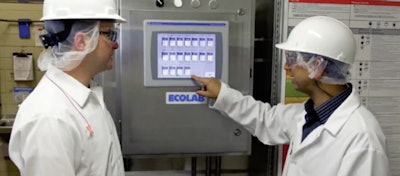Levels of automation can vary widely in the food and beverage industry, but advancements in data acquisition options are quickly driving companies toward optimization. Data acquisition options are now traveling farther upstream in the industry, making more inroads into processing equipment.
The “2017 Trends in Food Processing Operations” report from PMMI, The Association for Packaging and Processigng Technologies, reveals that nearly half of the 40 companies in the survey will be spending more on capital equipment in the next 12 to 24 months. The report also shows that operators and maintenance teams are employing predictive maintenance practices at a rate of 64 percent and preventive maintenance rates of 97 percent.
With more predictive and IIoT approaches being accepted as logical next steps, companies are installing sensors farther upstream in food processing operations, such as clean-in-place (CIP) applications.
“Better visibility of your clean-in-place applications can translate into a seven to ten percent increase in optimization,” says Joe Curran, senior staff scientist for food and beverage, Ecolab USA, at the Conference at ProFood Tech held in Chicago last month. The session, “Food Plant of the Future: Running on the Internet of Things,” featured case studies with the company’s 3D Trasar Analytical Platform for CIP applications.
A recent case study at Kemps’ dairy plant in Rochester, Minn. featured the company’s CIP analytical equipment. The Midwest dairy producer recently expanded its product offerings and needed an automated solution for better data analytics with its CIP parameters, including sanitizing.
According to a Kemps quality assurance manager, the physical checks and manual data analysis performed could assess only a fraction of all the possible CIP parameters. With this new automated analytical system, the dairy producer eliminated the need to pour through 1,500 charts generated per month by the plant’s CIP system for chemical concentration deviations.
The solution is flexible and, on the hardware side, can include existing CIP sensors, Ecolab sensors and a data acquisition module that sends plant data to a secure server for analytics. From there, Ecolab analytical experts provide recommendations on corrective actions.
“The more data points we have, the faster we understand the opportunities for improvement at customer sites,” says Curran. Parameters can include CIP supply and return temperatures, flow and conductivity sensors, valve positioning, PLC sequence steps and other variables to determine different phases.
Beverage producers are moving fast with CIP and taking a second look at their facilities. “Food safety is the highest priority, but product cost savings, water loss reductions and energy conservation are other considerations,” says Ola Wesstrom, senior industry manager for food and beverage at Endress + Hauser USA.
Food and beverage plants are also running more SKUs on equipment and production lines, so changeovers are affecting CIP. “With more changeovers, this can mean higher costs associated with CIP,” says Wesstrom. There’s an opportunity for time savings by going to a instrumentation-based CIP system versus purely timing based.”
Wesstrom also sees more interest in optical turbidity sensors for phase separation and to determine soil level in rinse water during CIP sanitization.
One cautionary aspect to more automation at the CIP level is security with operator and maintenance techs. “If there's no security, then attackers can degrade the integrity of the data,” says Bryan Downer, vice president of product management at CSI Designs. In addition, “you could have temperatures being offset from the actual setpoints due to techs trying to make something work for a short period of time and then it never gets fixed,” Downer adds.























